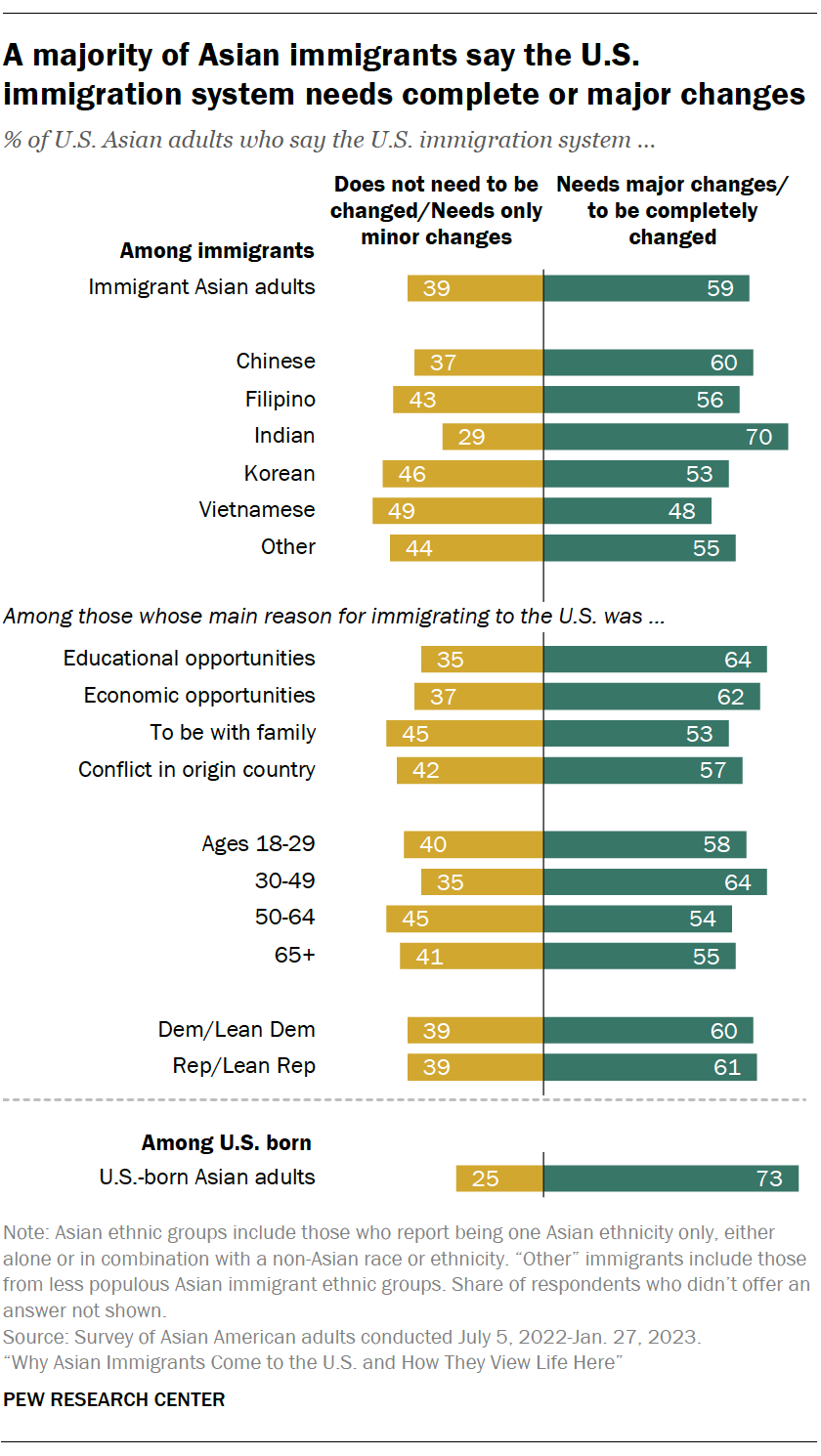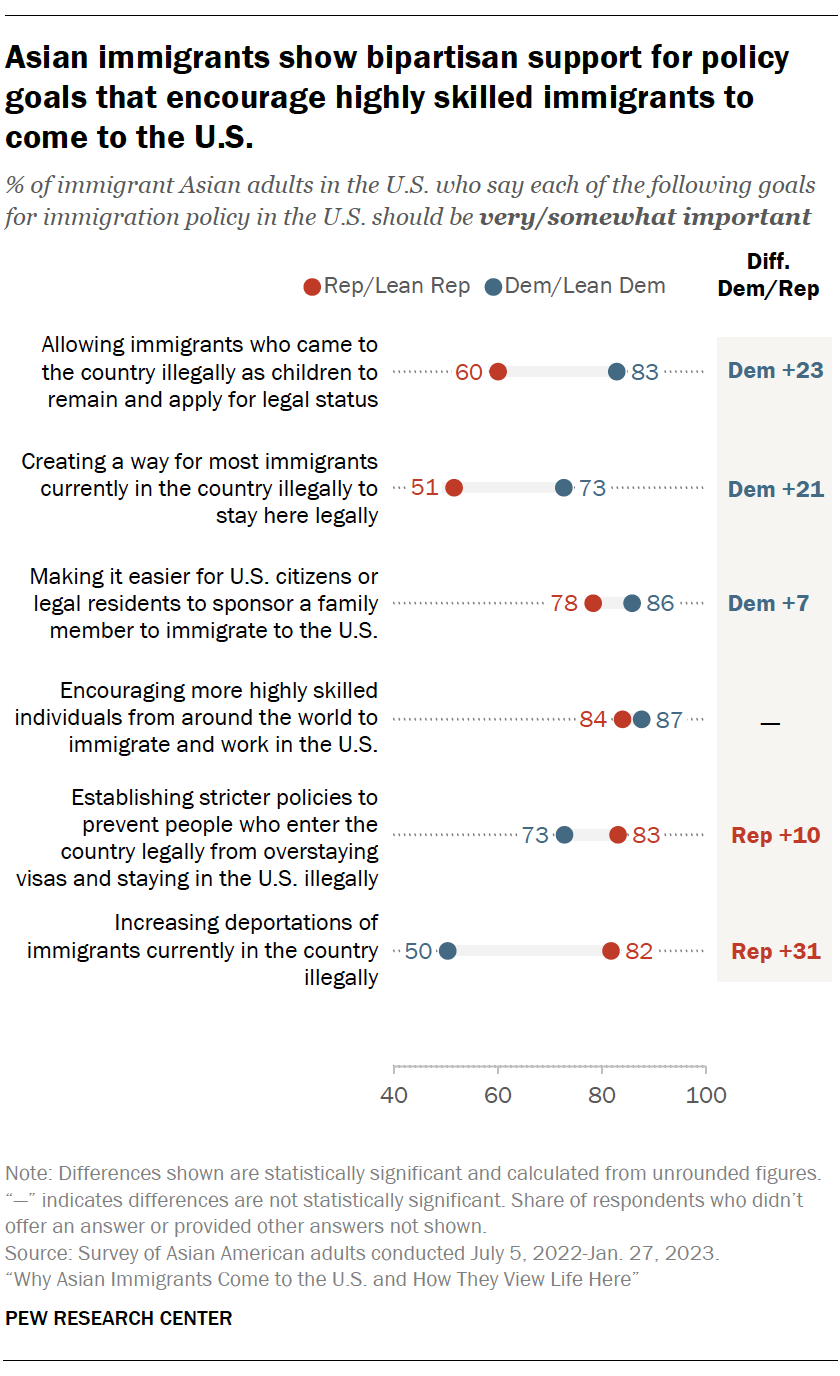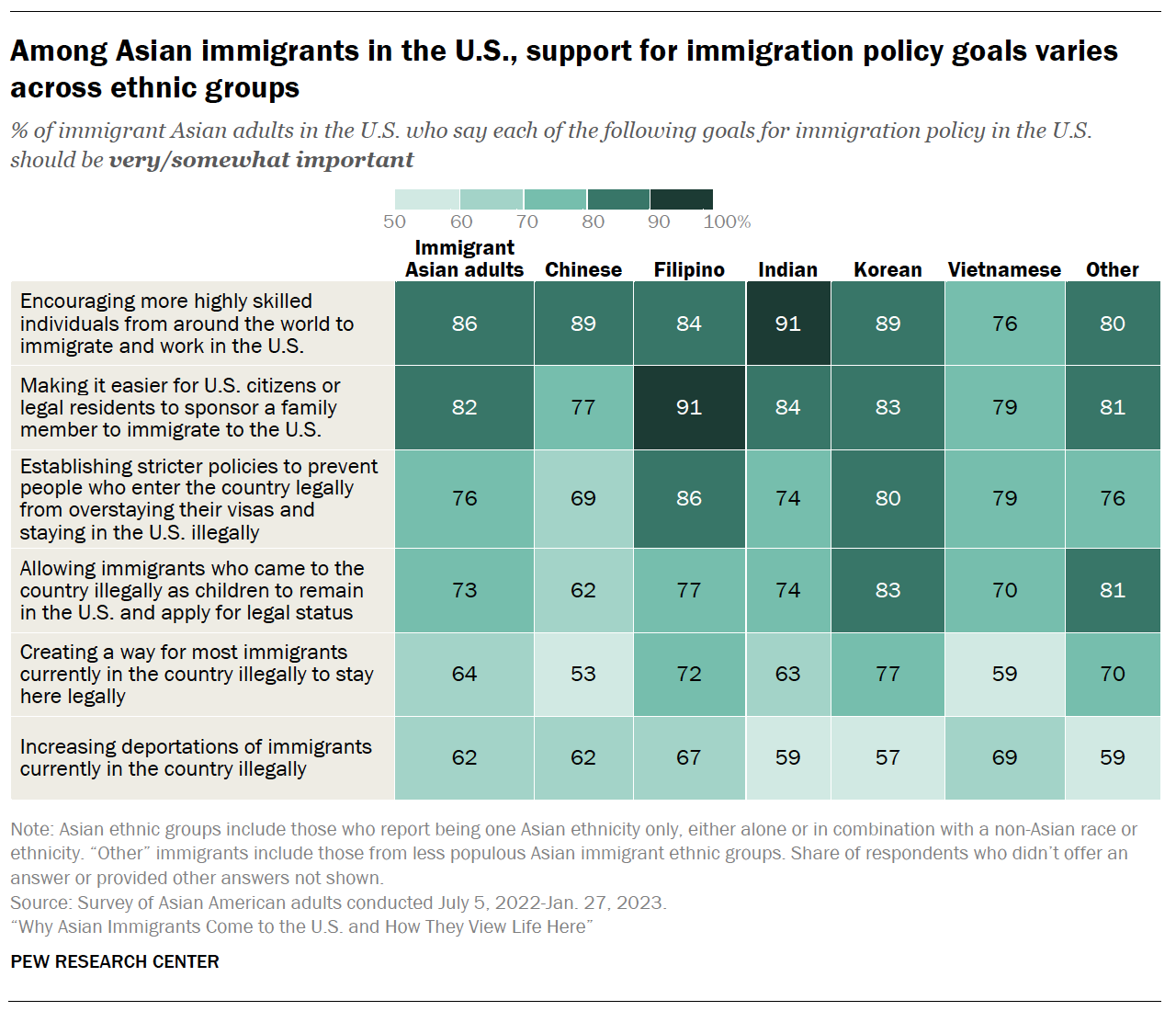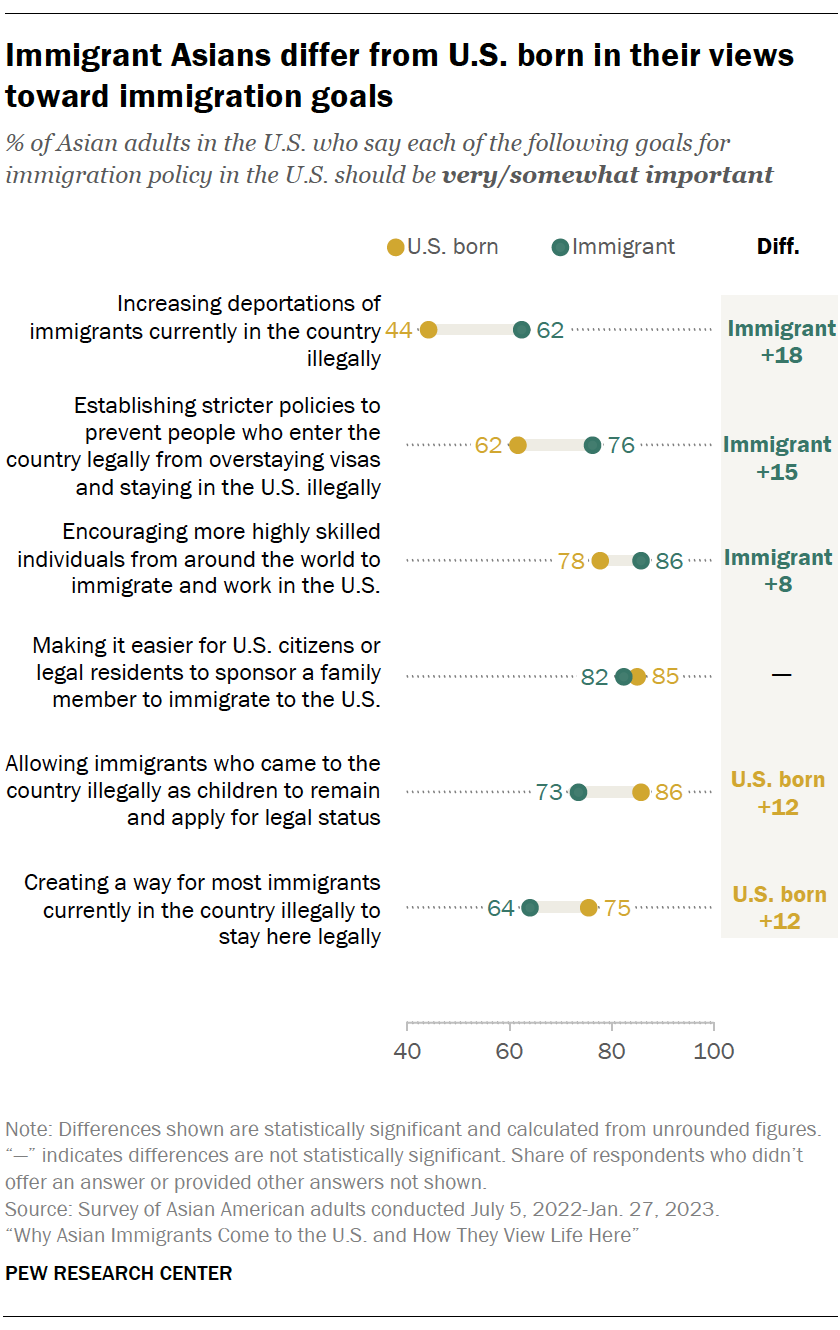With more than half of Asian Americans born outside the United States, a share that rises to 67% among Asian American adults, engagement with the U.S. immigration system is a common experience.
Asian American immigrants interact with the nation’s immigration system in different ways. Some Asian immigrants came to the U.S. under differing visa categories, including student visas and temporary work visas. Others obtained permanent residencies through family sponsorship, employment-based preferences, and diversity and refugee categories, among others.
Some 13 million Asian immigrants live in the United States, making up 32% of legal immigrants and 16% of unauthorized immigrants among the foreign-born population in the U.S. in 2022, according to a Center analysis of the American Community Survey.
About one-third of those obtaining lawful permanent residency (i.e., people getting a “green card”) in 2022 were born in Asia, according to an analysis of data from the Department of Homeland Security.9 Among those admitted under employment-based preferences, more than 60% were born in Asia; the largest numbers were from India, China and the Philippines.
Among refugees and people granted asylum in 2022, about a quarter were born in Asia.
Large numbers of people from Asia are admitted each year as lawful temporary migrants to work or study in the U.S. In 2022, about 70% of arrivals of temporary workers in specialty occupations (H-1B visas) were born in Asia; roughly two-thirds (64%) of arrivals on H1-B visas were granted to immigrants from India. About one-sixth of temporary managers (L-1 visas) were from Asia. Among international students arriving on F-1 visas, more than 40% were from Asia. Nearly 20% of all students arriving on F-1 visas are from India, more than 10% from China and about 5% from Korea.
Today, 60% of Asian immigrants are citizens. Another 28% are in the country legally as lawful permanent residents (20%) or temporary lawful immigrants (8%). And 13% are in the country without authorization, according to Pew Research Center estimates of the 2022 American Community Survey.
This chapter explores how Asian Americans’ views of the U.S. immigration system are linked with their diverse backgrounds. It also examines how U.S.-born Asian Americans see the U.S. immigration system and immigration policy goals.
Do Asian immigrants think the U.S. immigration system needs to change?

Overall, 59% of Asian immigrants say the U.S. immigration system needs to be completely changed or needs major changes. Views vary by factors such as ethnicity and the main reason for immigrating.
- Main reason for immigrating: About six-in-ten immigrants who came to the U.S. for educational or economic opportunities say the immigration system needs large changes, while about half of those who came to be with family say the same (53%).
- Ethnicity: 70% of Indian immigrants say the U.S. immigration system needs complete or major changes, a higher share than among other ethnic groups.
- Political party: Notably, views don’t vary by party among Asian immigrants. Republicans (61%) and Democrats (60%), including those who lean to each party, are equally likely to say the system needs complete or major changes.
Among U.S.-born Asian American adults, 73% say the immigration system needs to be completely changed or major changes, a higher share than among Asian immigrants (59%). Still, large majorities of both are critical of the U.S. immigration system. On the other hand, 25% of the U.S. born say the system needs minor or no changes, while 39% of immigrants say the same.
What U.S. immigration policy goals are important to Asian immigrants?
The survey, conducted between July 2022 and January 2023, asked Asian American adults about their views on specific immigration policy goals. Among Asian immigrants:
- 86% say encouraging more highly skilled individuals to migrate and work in the U.S. is a very or somewhat important goal.
- 82% say making it easier for U.S. citizens or legal residents to sponsor a family member to immigrate to the U.S. is important.
- 76% say establishing stricter policies to prevent people from overstaying their visas is an important goal.
- 73% say allowing immigrants who came to the country illegally as children to remain in the U.S. and apply for legal status is an important policy goal.
- 64% say creating a way for most immigrants currently in the country illegally to stay here legally is an important goal.
- 62% say increasing deportations of immigrants currently in the country illegally is an important goal.
By political party

Among Asian immigrants, Democrats are more likely than Asian immigrant Republicans to prioritize U.S. immigration policy goals that encourage immigration:
- 86% of these Democrats and Democratic leaners say making it easier for U.S. citizens or legal residents to sponsor a family member to immigrate to the U.S. should be an important policy goal, compared with 78% of Asian immigrant Republicans and leaners.
- 83% say allowing immigrants who came to the country illegally as children to remain in the U.S. and apply for legal status is important, compared with 60% of Asian immigrant Republicans.
- 73% say creating a way for most immigrants currently in the country illegally to stay here legally should be an important goal, compared with 51% of Asian immigrant Republicans.
Meanwhile, Republicans are more likely than Democrats to say goals that restrict illegal immigration are important for U.S. immigration policies:
- Most (83%) say establishing stricter policies to prevent people who enter the country legally from overstaying their visas is an important U.S. immigration policy goal. A smaller majority of Asian immigrant Democrats (73%) say this.
- Republicans in this group are also much more likely than Democrats to favor increasing deportations of immigrants in the country illegally (82% vs. 50%).
Notably, among Asian immigrants, only one policy goal received bipartisan support: encouraging more highly skilled individuals from around the world to immigrate and work in the U.S. (84% of Republicans and 87% of Democrats view this policy goal as important).
By ethnicity
Asian immigrants’ views also vary across ethnic groups. For example:
- Chinese immigrants (69%) are less likely than some other ethnic groups to say it is important to establish stricter policies preventing immigrants from overstaying their visas illegally. They are also less likely to prioritize policies that allow immigrants who are in the country illegally (53%) or who came to the country illegally as children (62%) to stay, compared with most other ethnic groups. Still, half or more of Chinese immigrants say these should be goals for U.S. immigration policy.
- Filipino immigrants are most likely to say making it easier to sponsor family members should be an important goal: 91% say this, compared with somewhat smaller majorities among other groups.
- Vietnamese immigrants (69%) are among the ethnic groups that are most likely to say it is important to increase deportations of immigrants currently in the country illegally. On the other hand, they are less likely than most other ethnic groups to say encouraging high skilled immigrants should be an important policy goal (76%), though a large majority say this.

(Refer to Appendix A for more information on how Asian immigrants’ views vary across demographic subgroups, including age and citizenship status.)
By nativity

Among all Asian Americans, U.S.-born Asian adults tend to be more supportive than immigrants of policies that establish stronger protections for unauthorized immigrants. Still, majorities of immigrant Asians say these policies are important.
Notably, majorities of immigrant and U.S.-born Asians differ on the importance of one policy goal: 62% of Asian immigrants say increasing deportations of immigrants currently in the country illegally is an important goal. Meanwhile, 55% of U.S.-born Asian adults say this goal should be not too important, if at all.
(For more information on U.S.-born Asian Americans’ views on immigration goals across demographic subgroups, refer to Appendix A.)




